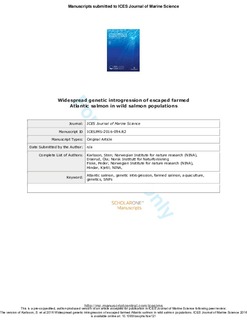| dc.description.abstract | Farmed Atlantic salmon (Salmo salar) escape from net pens and enter rivers to spawn, potentially resulting in genetic introgression and reduced fitness of wild salmon. Here, we quantify genetic introgression of farmed to wild salmon, using molecular genetic markers, in populations from 147 salmon rivers, representing three-quarters of the total wild salmon spawning population in Norway. For 109 rivers with adult modern samples and sample sizes of 20 or more, the average level of farmed genetic introgression was 6.4% (median¼2.3%), with a range between 0.0% and 42.2%. Fifty-one of these rivers showed significant farmed genetic introgression when compared with historical reference samples.
We observed a highly significant correlation between estimated farmed introgression and average proportion of escaped farmed salmon.
We quantify levels of introgression as unweighted averages or weighted by population sizes, to compare geographical regions and to compare levels of introgression in rivers and fjords designated as locations deserving a high level of protection. We found a generally lower level of introgression in National Salmon Rivers and National Salmon Fjords subjected to formal protection by parliament. We conclude that farmed to wild genetic introgression is high in a large proportion of Norwegian salmon rivers, with the highest levels found in the most intensive areas of salmon farming. The extensive genetic introgression documented here poses a serious challenge to the management of farmed and Wild Atlantic salmon in Norway and, in all likelihood, in other regions where farmed-salmon escape events occur with regularity | nb_NO |
